
- LAST UPDATED: December 6, 2023
Have you occasionally spotted dark, sausage-shaped mass on the couch, bed or the floor? If yes, then you’re glaring at a mouse droppings menace! You should, however, remain calm and desist from handling the excrete using your bare hands. Cleaning up the mouse droppings immediately you spot them is critical in enhancing hygiene as well as preventing severe health hazards that may result from uncontrolled interaction with the waste materials. This article will give you necessary tips on handling the problem. It’ll clearly articulate the procedure to apply in eliminating the droppings, regardless of their location, while safeguarding your health.
Contents
What to do if you find mouse droppings
If you’ve confirmed the presence of the rodent’s poop, you need to devise a safe method to get rid of them. You should never handle the droppings without gloves to minimize the risk of acquiring infectious agents that are a threat to your health.
The first step you should initiate when you find the dark, brown pellets is identification. You need to be sure of what you’re handling. Most of the parameters used in the process does not require physical handling of the fecal material!
The list below gives crucial points on the do’s and the don’ts in such a scenario:
- Don’t Overreact. The presence of the mouse poop inside your house is unsightly but you should restrain yourself. The first reaction would be to sweep them away using a broom as quickly as you can. The action, can, however, expose you to health dangers!
- Don’t use a vacuum cleaner. When trying to get rid of the mess, you may be tempted to vacuum clean your house. If the poop contains disease-causing agents, it’s likely that you’ll blow them off allowing easy inhalation and consequently leading to illnesses.
- Don’t handle the mice droppings using your bare hands. Always ensure that you put on your rubber or latex gloves.
- Do air the area before cleaning. Open all the windows to allow free air circulation which minimizes the chances of inhaling the disease-causing microorganisms.
- Do collect and dispose of all the droppings in a sealed bag then put them in a covered trash can.
Your safety, as well as the well-being of your children and pets, is vital. As such, you should ensure that you follow these tips to the letter to avoid inhaling harmful agents that can make you seriously ill.
Mice poop: Identification
Have you found dark masses inside your house but you aren’t sure what they are? You should undertake a proper identification process before handling them to eliminate all the risks that are associated with mouse droppings.
The rodents excrete fecal matter in pellet form and can deposit between fifty and seventy-five pellets in a single day. The droppings are usually dispersed in regions that are heavily infested by rodents.
The following tips will allow you to make an informed decision on the identity of the masses:
- Shape. The knowledge of the appearance will help you differentiate between the mice’s poop from that of a rat. The droppings are granular in shape and resemble rice grains. Although there are a few rounded pellets, the majority of the droppings are tapered either at one end or both ends. The shape ensures that you do not confuse the mouse poop with that of a rat or any other rodents which ideally produces rectangular/spindle shaped droppings.
- Size. This parameter is a crucial element that helps you to undoubtedly set apart mouse’s droppings from the rest; mice excretes smaller poop pellets measuring between 1/8 and 1/4 inch.
Rodent Droppings - Color. The poop will either be brown or dark depending on the type of seeds the mice consumed. In most cases, it’s initially brown and soft, turns dark and hardens after several hours and eventually becomes grey.
- Amount. It’s crucial to note that the amount of the pellets is lesser with the mice compared to other rodents. They are usually scattered and not concentrated in a single place.
If what you found in the house has the above description, do not panic! The droppings will not cause any harm if the right procedure of their elimination is followed.
Mice droppings in the house
The rodent’s poop presents an ugly sight especially when they are in an open place in your house.
They primarily infest food-rich and dark regions including:
- Behind Kitchen Cabinets.
- Dark corners of the house.
- Pantries and food stores.
- Attics and Crawl Spaces.
The mice frequent these areas due to food availability as well as a conducive environment for them to establish their nests. If you, therefore, spot the dark cylindrical droppings here, it’s highly likely that you’ve identified mouse poop! When that happens, you should embark on a cleaning process to decontaminate the house. The mice are shy and it’s thus unlikely that you’ll find the droppings on the couches or the carpet. In case this happens, you should not use your broom or vacuum cleaner to avoid inhaling disease-causing microorganisms.
In oven
Mice like spending their time in an area where they can easily access food. This behavior explains their dominance in your kitchen! As such, it’s not uncommon to find their pellet-looking droppings in the oven. While the poop looks bad and everyone thinks it’s unhygienic, it actually does not expose you to as much harm as the poop dropped on the ground. The oven heat significantly incapacitates and eventually destroys the disease-causing microorganisms. That does not mean, however, that you should let the droppings stay!
Follow the following simple steps to remove the dirt from your oven:
- Prepare bleach solution. Ensure that you use ten parts of water and one part of bleach. Once that’s achieved, you should apply it on your stove and allow it to soak for a minimum of fifteen minutes.
- Wipe off the bleach solution using a clean piece of towel. As you wipe, ensure that the droppings are carefully collected and disposed of into a sealed container.
- Immediately after wiping off the bleach, you should apply 70% alcohol solution and let it stay for approximately 5 minutes then wipe it off.
In case you need to restore fragrance on the stove, you can use a fragrant such as rosemary, lavender oil or any other product designed to eliminate the stench akin to that produced by a dead, rotting mouse. You can get more information on how to get rid of dead mouse smell here.
On the stove: Now what?
Are you disgusted by the discovery of mouse droppings on your stove? Well, relax! Cleaning up mouse droppings from your stove is a simple process that shouldn’t stress you. First, you need to spot all the droppings by separating the stove’s parts. Once you do this, you should embark on the crucial step of removing the unsightly pellets from the stove.
Wear latex or rubber gloves and dissolve the pellets in a bleach solution.
After they’ve settled in the solution for approximately fifteen minutes, remove them using a piece of cloth and put them in the garbage pit. You should then apply 70% alcohol on both the interior and exterior parts of your stove for disinfection and decontamination. Let them dry up and reassemble the stove for use. If you detect a stench, you can use fragrant materials to restore the full functionality of your stove.
How to get rid of mouse droppings
The surest method of getting rid of the mouse droppings completely is by ensuring that all the mice in your house are exterminated!
Droppings should thus be exterminated to prevent exposure to the dangers. Ensure that you apply proper methods to either repel or kill the mice including traps, poison baits, and other repellents. If you want to find how to kill mice, go here. The first step of a successful elimination process involves identifying the areas infested by the rodents and setting up traps and other baits you may decide to apply.
The kitchen is the primary target due to its proximity to food sources, water, and conducive places to hide. It’s, however, vital that you exercise caution when placing poisons in regions near food sources to avoid contamination of the foodstuffs which may be lethal to your family members. Read on the best way to get rid of mice in the kitchen here.
If you’re already struggling with the droppings menace, you should follow the procedure detailed below to clean up the mouse droppings:
How to safely clean mice droppings
Cleaning up mouse droppings is a high-risk exercise that requires you to exercise high-level caution. The poop may expose you to Hantavirus which causes a potentially fatal disease. The microbes that cause this illness are passed through the droppings and urine of an infected mouse. When you disturb the mice droppings, the agents dominate the air after which you'll breathe the infected air and acquire the illness.
You should follow these 5 steps to eliminate the chances of getting infected
Ventilate the room 30 minutes before you start the clean-up
You should ensure that you open all the doors and windows. Once you achieve this, leave the house and allow the room to air for 30-45 minutes.
Soak droppings in a disinfectant
You should spray all the regions, with the poop, using a DIY disinfectant. Prepare the solution by mixing one part of bleach with ten parts of water. Once you've sprayed all the affected areas, allow it to settle for approximately five minutes. Do not handle the droppings before at least five minutes are over after the soaking process!
Wear latex or rubber gloves
Ensure that you do not touch the poop with your bare hands. With the gloves on, look for a rag and mop up the wet droppings. You can also pick them up using paper towels. Once you've collected them, you should immediately dispose of them in a plastic bag. Carefully put the bag into a garbage container with a fitting lid.
Thoroughly wash gloves before removing them
After successfully collecting the poop, ensure that you clean your gloved hands to avoid transferring the dirt and potentially disease-causing microorganisms into other parts of your body. Carefully remove the gloves and put them in the tightly closed garbage bin.
Wash your hands!
You should use warm water and plenty of soap to clean your hands after which you should dry them using a clean towel and apply a topical disinfectant.
If you are uncomfortable with handling the procedure, you should always consult professionals to help you in cleaning up the mouse droppings. This is a sure way of guaranteeing your safety as well as that of the people you live with.
In case you observe the following symptoms two to five weeks after the process, you should consult your physician urgently:
- Fever.
- Body aches.
- Breathing difficulties.
- Body chills.
Cleaning up mouse droppings is a necessary exercise but it exposes you to numerous disease-causing agents. As such, you should carry out the process following all the recommended guidelines as detailed herein. In case you lack the confidence to follow the procedures to the letter, you shouldn’t risk it! Instead, you should involve a professional to help you clean up the mess left behind by the stubborn rodents.

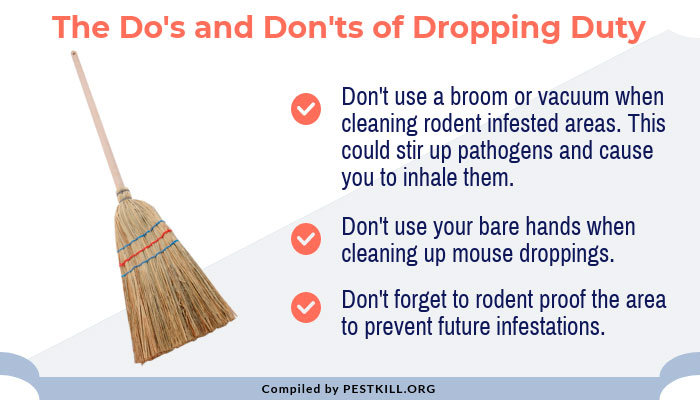
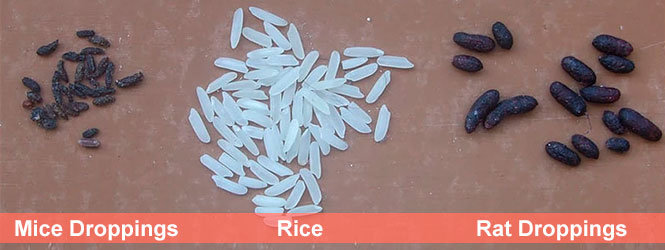

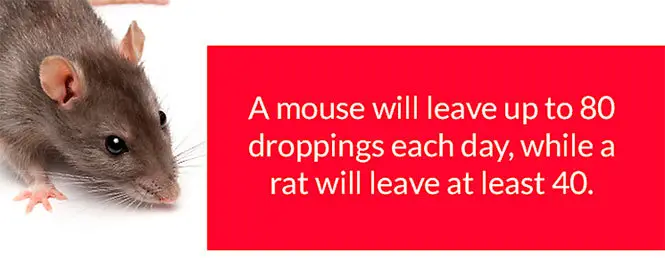
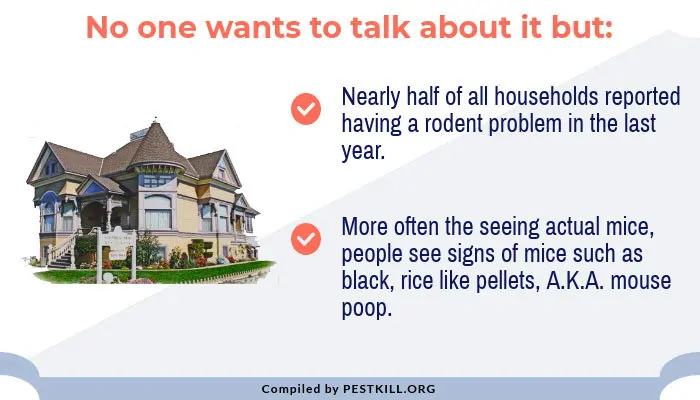
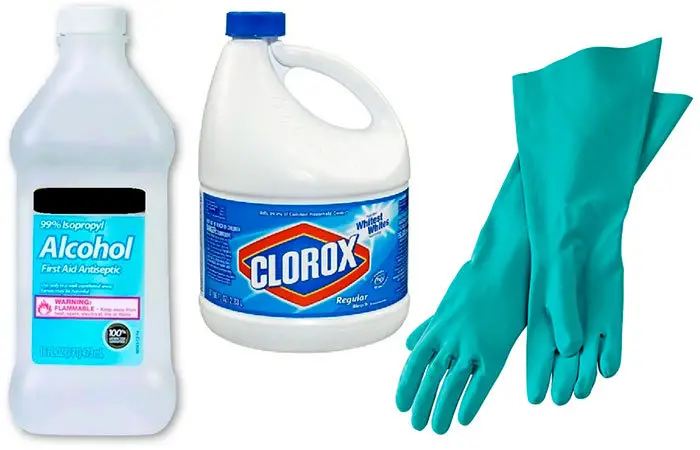
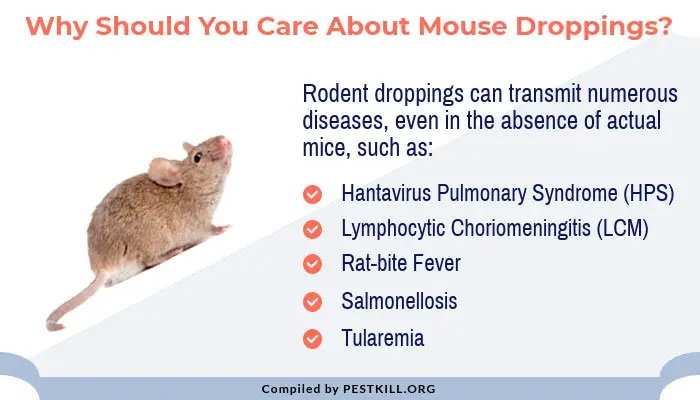
 You should ensure that you open all the doors and windows. Once you achieve this, leave the house and allow the room to air for 30-45 minutes.
You should ensure that you open all the doors and windows. Once you achieve this, leave the house and allow the room to air for 30-45 minutes. You should spray all the regions, with the poop, using a DIY disinfectant. Prepare the solution by mixing one part of bleach with ten parts of water. Once you've sprayed all the affected areas, allow it to settle for approximately five minutes. Do not handle the droppings before at least five minutes are over after the soaking process!
You should spray all the regions, with the poop, using a DIY disinfectant. Prepare the solution by mixing one part of bleach with ten parts of water. Once you've sprayed all the affected areas, allow it to settle for approximately five minutes. Do not handle the droppings before at least five minutes are over after the soaking process! Ensure that you do not touch the poop with your bare hands. With the gloves on, look for a rag and mop up the wet droppings. You can also pick them up using paper towels. Once you've collected them, you should immediately dispose of them in a plastic bag. Carefully put the bag into a garbage container with a fitting lid.
Ensure that you do not touch the poop with your bare hands. With the gloves on, look for a rag and mop up the wet droppings. You can also pick them up using paper towels. Once you've collected them, you should immediately dispose of them in a plastic bag. Carefully put the bag into a garbage container with a fitting lid. After successfully collecting the poop, ensure that you clean your gloved hands to avoid transferring the dirt and potentially disease-causing microorganisms into other parts of your body. Carefully remove the gloves and put them in the tightly closed garbage bin.
After successfully collecting the poop, ensure that you clean your gloved hands to avoid transferring the dirt and potentially disease-causing microorganisms into other parts of your body. Carefully remove the gloves and put them in the tightly closed garbage bin. You should use warm water and plenty of soap to clean your hands after which you should dry them using a clean towel and apply a topical disinfectant.
You should use warm water and plenty of soap to clean your hands after which you should dry them using a clean towel and apply a topical disinfectant.





